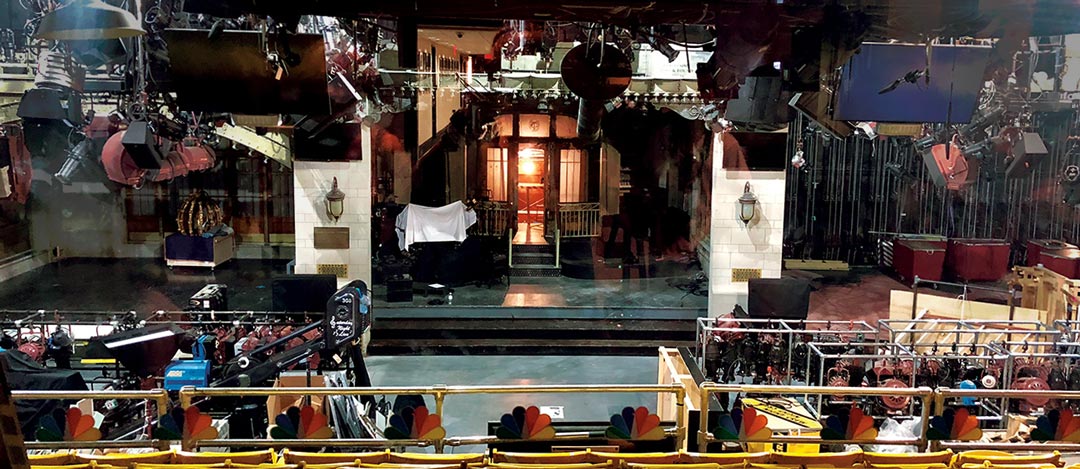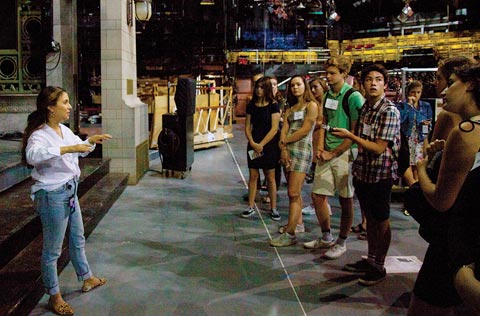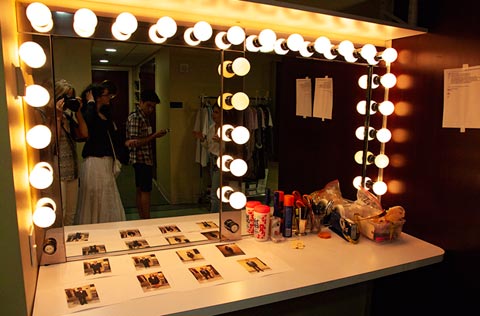FEATURE - August, 2018
On Location at SNL
An Interview with SNL's Steve Higgins
REPORTERS: C.C. Clark, Kyle Austin, Lily Baldwin, Kylar Flynn, Brandon Lopez, Simone Harper, Angie Gonzalez, Sabine Lloyd, Jacqui Martin, Lauren McKechnie, Claire McKechnie, Samantha Michaels, Josh Santos, Anna Silverman, Campbell Slavin, Lilli Wanninger
A s Jimmy Fallon’s announcer and sidekick on The Tonight Show, Steve Higgins is a familiar figure on the TV landscape. In fact, to many viewers, Higgins’s casual wit and perfect chemistry with Fallon make him the best part of that iconic show. But for Higgins, this high-profile gig is his time to goof off, have fun and “go out to lunch” on company time. So, if Tonight is Higgins’ lunch break, what’s his day job? Lesser-known fact: Higgins is also a top producer of that other legendary late-night NBC comedy show, Saturday Night Live, now in its 44th season. We met up with Higgins at that equally legendary Manhattan skyscraper where all the magic happens—30 Rockefeller Plaza, aka 30 Rock—to talk SNL, The Tonight Show and comedy in general.
Higgins helps oversee the writing for perhaps the most popular live sketch comedy ensemble in the world—no pressure!—and spends an enormous amount of time in the SNL writers room, birthplace of some of the most famous comedy routines from the past half-century, a place most comedians only visit in their wildest dreams. As it turns out, the SNL writing process isn’t exactly how we thought it would be. According to Higgins, the writers start by coming up with sketches on their own or in small groups. Then they gather together in the writing room, choose the sketches for the upcoming show and pitch ideas for different lines and jokes in each other’s sketches. And how do they choose which jokes and lines will make it into a sketch?

One rule that surprised us is that if a joke makes everyone in the room laugh too much, out it goes. Higgins explains, “After you’ve been in comedy your whole life, what makes you laugh is different from what makes humans laugh. So, if we’re laughing too hard, we go ‘Oh no, we’ve got to tone this down a little bit.’” (On that note, Higgins says that it’s practically impossible to predict which sketches will be a hit with the audience—in fact he’s often surprised by the sketches that audiences end up loving.) Another rule: Don’t mess with the possibly conflicting styles of other comedians—keep the essence of that thing that makes them popular while helping make it work in the sketch.
Higgins’ comic inspiration comes from his family. Growing up, his skills as a comedian blossomed, he said, from making his brothers laugh and taking note of what worked and what didn’t. Additionally, when SNL first started to air, his mom would let him stay up to watch it, adding fuel to his comedic fire. He and his brothers watched other classic comedy shows as well, like Monty Python, SCTV and Kids in the Hall, and created their own sketches inspired by what they’d seen. His second source of inspiration was…Italian food. “Italian food is making the best with what you have,” he explained. “So if the tomatoes are no good, there’s no tomatoes that day. If the chicken is not good, there’s no chicken on the menu that day. So it’s dealing with what you have at the time to make that the most perfect thing as opposed to going, well, it’s great on paper, but then when you go to do it, the person can’t say the line right, they can’t do the thing right, so everything changes. So instead of fighting it, I got with it, because I don’t see [SNL] as a magazine, I don’t see a script as a done deal or as the finished product. The finished product is when it airs at 11:30.”
 Higgins’ family also influenced the start of his career. When he was younger, he never saw comedy as an option. But when the standup scene began to mushroom in the late ’70s and early ’80s, his brother began to do comedy in Des Moines (Higgins grew up in Iowa). Higgins joined his brother’s group after college, and when they moved to Los Angeles, Jon Stewart called and asked him to write for his show, a less successful predecessor to The Daily Show. After it was canceled, Higgins went to work for SNL and has been there ever since.
Higgins’ family also influenced the start of his career. When he was younger, he never saw comedy as an option. But when the standup scene began to mushroom in the late ’70s and early ’80s, his brother began to do comedy in Des Moines (Higgins grew up in Iowa). Higgins joined his brother’s group after college, and when they moved to Los Angeles, Jon Stewart called and asked him to write for his show, a less successful predecessor to The Daily Show. After it was canceled, Higgins went to work for SNL and has been there ever since.
So how does Higgins balance the sketch-comedy craftsmanship of SNL against the more spontaneous wit of The Tonight Show? “Very well,” he said. “I just go down [the elevator to Studio 6B] and do Jimmy. I don’t write there. I don’t produce there. I just goof off there.”
What advice would Higgins offer to aspiring writers and comedians? “Write. That’s it. And you have to make it a regimented daily thing if that’s what you want to do, because somebody out there’s going to work ten times as hard as you. But you also have to stop now and then and live your life. Because [even though] you stop physically writing, your brain doesn’t stop. But you won’t give it a chance to create if you’re constantly on YouTube or watching Instagram or not letting your brain accept the muse that’s out there.”
Especially important is to have fun while you’re doing it. “Like I tell new writers when they come here: either you can get paid to be miserable or paid to have fun and laugh. It’s up to you; your choice, either way, because you’re getting paid the same if you have a horrible time doing it or a great time doing it, so why not have a great time?”
Sarah’s Tour
By C.C. Clark
Before we went to the writers room to interview Steve Higgins, we toured Studio 8H, where Saturday Night Live is produced. For somebody who lives and breathes SNL, this encounter was beyond exciting: I found myself starstruck knowing that I was standing where all of my favorite comedians once stood.



The stage was immediately recognizable but the rest of the space wasn’t. Lights were everywhere—the ceiling, the ground, the walls. Audience seating was behind the filming area, and a large hallway-facing window was opposite the stage, only on a higher level.
Wandering through the hallways, we saw one legendary thing after another—costumes displayed behind glass (including one worn by Kristen Wiig’s Target Lady character), posters signed by hosts and musicians, and the offices of the cast members as well as of SNL producer and creator Lorne Michaels.
Our tour was led by Sarah Moses, former FastForward reporter and current personal assistant to Steve Higgins himself. She offered up lots of fun facts about SNL—that each week’s set is built in just two days, on Thursday and Friday, for instance, and that musical guests have complete creative control over their part of the show—set design, props, everything. She pointed to the director’s chair Michaels occupies during dress rehearsals, giving feedback to the writers whose sketches are being performed.
Being immersed in a piece of television history is an experience I’ll never forget.
